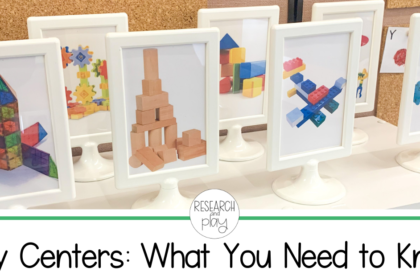I have had to be creative with my scheduling over the past few years. Our kindergarten day is two hours shorter than the day I taught at my previous school. I knew there were things that would have to be sacrificed, but there are a few things that I knew I would never give up no matter how I had to squeeze them in! Below you will see our daily schedule. You will see that our day is packed full! I will continue this series in the next few weeks to share how we structure each part of our kindergarten day.
Aside from the required reading, math, writing, and specials blocks, I knew that our schedule had to incorporate time for my teaching passions (the hills that I will die on as my previous principal used to say). The first of these is our PLAY CENTERS.
As you will see above, our daily schedule includes 15 minutes of structured, planned, and intentional play EVERY DAY. This is the one part of our day that I will never give up! It can get loud, messy, and sometimes go beyond 15 minutes, but it is worth it! We know why play is important: children are social learners, they need time to practice social skills, they need to get their energy out, it gives them a creative outlet….
But I love play in the classroom probably for this reason the most: Structured play time gives all students – no matter their reading proficiency, math skills, or writing ability, no matter their native language, no matter their home life – a chance to connect to one another.
The conversations I overhear during playtime have revealed to me more about my students than I ever would have found out during typical classroom interaction. I have heard my students laugh, sing, pretend, argue, and disagree. I’ve watched wallflowers who never speak up create the most amazing structures in the block area, the student who has no English language proficiency laugh with his friends at the water table, and the most hyperactive of boys sit down and paint a beautiful picture of his family.
And for all the small instances I see it, the kids see it even more! They start to learn how to communicate and connect. They see common interests or find out hidden talents. Even if they never play together on the playground, I see students laughing and pretending together in dramatic play. Play unites children. It unites us as a whole classroom community. And I absolutely think it is important. There is always time for play!
Below you will see the 7 play centers that we use in our classroom. I’ve included some things below each picture that you could include in the center for your students. I rotate what is in each of my centers about 2-3 times per year, that’s it! I love how my students get connected to the materials. They keep coming back to the same things and are able to adjust their plans and recreate amazing things!
- Long Sterilite container found at a home improvement store
- Bins underneath to store supplies that are rotated depending on what is in the table
- Materials to put in the table for discovery: water and soap, dried pasta and beans, sand, potting soil and seeds, “moon dough” (recipe on my Pinterest board), cornmeal
- Supplies for discovery: shovels, scoops, funnels, scrubbing brushes, small pots, children’s gardening tools, small measuring cups
- Play kitchen
- Child-sized aprons
- Various hats or other dress-up clothing
- Empty food and beverage containers from home
- Plastic or ceramic plates, bowls, and cups
- Plastic or metal forks and spoons
- Kitchen utensils (spatula, tongs, etc.)
- Small pots and pans (found mine at IKEA)
- Anything that students could use to build (Wooden blocks, Legos, Duplos)
- Random items that you would like to see students try to use to build with (shower curtain hoods, empty cans, yarn, binder clips, fabric – my students have created zip lines and tents on chairs from these materials!)
- A big basket to store these items
- Items are rotated in and out, not all out at once
- 3-drawer Sterilite container for storage (one activity per drawer)
- Anything that children would need to use their small motor movements to work with
- Lacing buttons/cards, peg boards and rubber bands, gears, tweezers and beads, clothespins and dried pasta, various sizes of screws and nuts (More ideas on my Pinterest board)
- Items are rotated in and out 3 at a time
- 3-drawer Sterilite container for storage
- Playdoh of any variation
- Tools for cutting, rolling, squeezing
- Stamps
- Small containers for sorting (bowls, baskets, jars)
- Any small items! This center is very broad. I have colored stones, rocks, seashells, marbles, and buttons.
- Magnifying glasses
- Construction paper of various sizes and colors
- Crayons, markers, oil pastels, watercolors, tempera paint, colored pencils, paint brushes, scissors, glue, and any other art materials you like












Your centers look like so much fun, and I can see how the children are learning through these experiences. I want to play in your room too! 🙂
This is fantastic! My students all arrive on the buses or are dropped off so they often arrive at different times. As is the case with lower elementary, it is often hard to entertain them as we wait for the day to begin. I will be implementing play stations first thing in the morning this year so that my students have these opportunities as well.